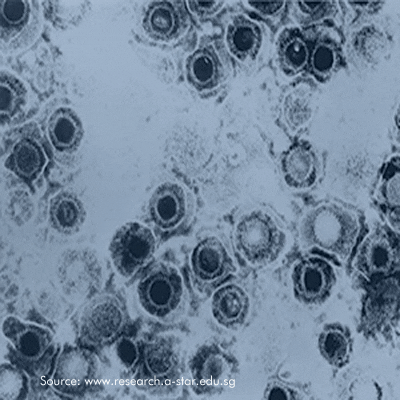
Get A Testing Quote
Human Herpesvirus I
| Structure | Enveloped |
| Family | Herpesviridae |
| Disease(s) Caused | Cold sores on the face and/or lips; can also be contracted genitally |
| Symptoms | Burning or tingling sensation preceding appearance of blisters: prodrome |
| Potential Complications | Herpes simplex encephalitis (newborns); Ocular herpes; Gingivostomatitis |
| Transmission Mode | Person-to-person via transmission of infected skin cells, fluid containing the virus from ruptured blisters. |
| Natural Reservoirs | Humans |
| Select Outbreak Sites |
Hospital Wards; Schools, Homes |
Importance of Human Herpesvirus I (HSV1)
Herpes simplex virus 1 (HSV-1) – also referred to as human herpes virus-1 (HHV-1) – infects the facial area, causing cold sores and fever blisters primarily on the lips and occasionally on the cheeks, nose, and tongue (oral herpes). Less commonly, HSV-1 can also infect the genital regions of males and females, producing lesions in these locations as well. The first episode of oral herpes most humans experience is during childhood, although HSV-1 can be contracted during any phase of life. Termed as “primary herpes”, symptomatic individuals may suffer from fever, swollen glands, bleeding gums, and painful sores in and around the mouth for several days time. During this period, infectious virus can be transmitted from person-to-person by direct contact with infected skin cells or via secretions from blisters and lesions.
The virus gains access to the host by way of mucous membranes, or through compromised/broken skin. Shedding of infectious herpes viruses continues for several days after lesions have healed. In addition, asymptomatic carriers of herpes simplex 1 shed the virus.
Populations susceptible to complications from herpes simplex 1 virus range from newborns to carriers who develop among the rarest of complications. Females that contract the genital form of herpes simplex 1 towards the end of pregnancy, remain asymptomatic, and then deliver vaginally pose a particular risk as 30% to 50% of their newborns subsequently develop infections. Herpes encephalitis is a rare brain disease that can be fatal if left untreated, and athletes who participate in direct contact sports wearing no protective clothing can develop a rare form of HSV-1 (herpes gladitorium) that causes lesions on the head and eyes of afflicted individuals.
The Importance of Disinfection: Survival of Human Herpesvirus I (HSV1) on Surfaces and Transmission Potential via Fomites
Herpes simplex-1 is an enveloped virus that spreads primarily by direct contact with the infected skin and/or secretions of carriers. However, it can also be transferred from experimentally-inoculated environmental surfaces (fomites), such as metal and plastic door knobs, to hands for a period of up to two-hours (2). HSV-1 has also been demonstrated persistence on dry, inanimate surfaces for up to seven days (3). However, the inactivation rate of HSV-1 is relatively high on environmental surfaces, especially upon drying. The ability of HSV-1 to remain viable on surfaces and be subsequently transferred to human skin makes it a skin pathogen of low to moderate concern. This potential transmission route can potentially be disrupted by the use of antiseptic agents. Bleach (2,000 ppm) was able to demonstrate complete inactivation of HSV-1 after 10 minutes, and 70% isopropanol (1 part virus stock:1 part alcohol) at time zero (1).
References
- Croughan, W.S. and A.M. Behbehani. 1988. Comparative study of inactivation of herpes simplex virus types 1 and 2 by commonly used antiseptic agents. Journal of Clinical Microbiology. 26: 213-215.
- International Scientific Forum on Home Hygiene. 2002. The infection potential in the domestic setting and the role of hygiene practice in reducing infection. 1-49.
- Kramer, A., I. Schwebke, and G. Kampf. 2006. How long do nosocomial pathogens persist on inanimate surfaces? A systematic review. 6:130.
Share

